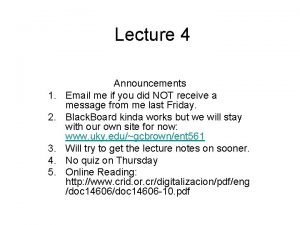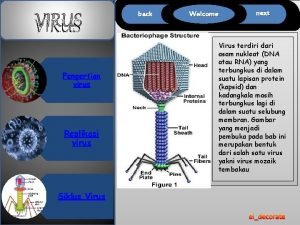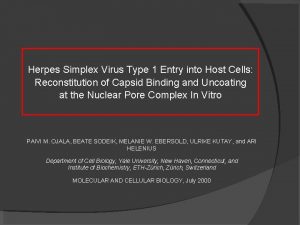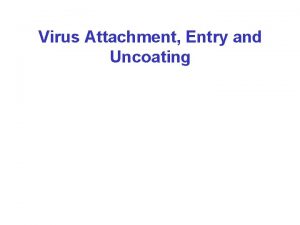VIRUS ENTRY Virus Entry Entry Into Host Cell












- Slides: 12

VIRUS ENTRY

Virus Entry • Entry Into Host Cell – Virus mission to infect as many cells as possible – Enveloped viruses utilize both fusion and endocytosis for entry making use of surface receptors – Naked viruses utilize endocytosis • Bursting and cell death occurs during release of naked viruses


Surface Molecules • Cell Surface Receptors Facilitate Viral Entry – These receptors have other functions, simply exploited – Ex. CD 4, PVR, CD 46, CAR, Integrins, LDL receptor family • Carbohydrate Molecules on Lipids/Proteins Allow Viral Binding – Sialic acid is a sugar moiety that is being used by influenza and paramoxyviruses for entry – Binding has to be terminated for productive infection to occur – Neuroaminidase cleaves sialic acid in the case of influenza virus • Not Uncommon For Viruses to Use 2 Receptors – Ex. HIV, utilizes CD 4 and CCR 5 or CXCR 4 • One receptor for docking and one for endocytosis • Naked Viruses Rely on Capsid for Attachment – Ex. Adenoviruses


Receptor Mediated Endocytosis • We Will Refer to Clathrin Coated Pits Mechanism – Very common entry method – Via clathrin coated pits – Endocytic vesicle allow virus to move to nucleus – Low p. H triggers escape from endosome – Timing is of essence since virus can end up in a lysosome and be eliminated



Importing Genome Into Nucleus • Advantages of Importing Genome Into Nucleus – Utilize host enzymes such as RNA polymerases, DNA polymerases and RNA processing • Disadvantage Is That Genome Has to Go Through Nuclear Pore • In Case of Retroviruses They Have to Wait For Nuclear Membrane Disintegration During Division to Occur – Lentiviruses are an exception – That is why retroviruses infect dividing cells more efficiently • Herpes Viruses and Adenoviruses Bind Nuclear Pore – They inject genome into nucleus – Capsid is too bulky to pass through pore

Importing Genome Into Nucleus • Some Viruses Enter Nucleus With Intact Capsid – Ex. Parvoviruses – HIV – Hep B – Influenza – Compact and economical • Picornaviruses – Unload as soon as entering host • Capsid stays at plasma membrane OR endosome • Hep B Virus – Unload as soon as entering nucleus • Intermediate Unloading: Herpes and Adeno – Capsid stays at nuclear pore


Ways To Block Viral Entry • Vaccination – Antibodies are generated which can block entry by binding envelope or capsid proteins – Antibody binding on capsid/envelope proteins interferes with binding on host receptors – Vaccination can be extremely effective in blocking entry • Soluble Versions of Receptors Utilized by Viruses to Enter – They bind virions and prevent binding on host receptors • Antibodies That Bind Host Receptors – These antibodies block attachment of virions onto host • Compounds That Block Acidification of Endosomes – Ammonium Chloride – Monensin (protein transport inhibitor) – Chloroquine (also used as anti-malaria drug) •
 Definitive host vs intermediate host
Definitive host vs intermediate host Cell city analogy
Cell city analogy Denuding tower
Denuding tower Prokaryotic cell vs eukaryotic cell
Prokaryotic cell vs eukaryotic cell Prokaryotic cell and eukaryotic cell similarities
Prokaryotic cell and eukaryotic cell similarities Plant vs animal cells organelles
Plant vs animal cells organelles Cathode and anode half reactions
Cathode and anode half reactions Dry cell vs wet cell
Dry cell vs wet cell Venn diagram animal and plant cells
Venn diagram animal and plant cells What is the function of cell wall in plant cell
What is the function of cell wall in plant cell Plant cell structure
Plant cell structure Structure of plant cell
Structure of plant cell Cell wall cell membrane
Cell wall cell membrane






















